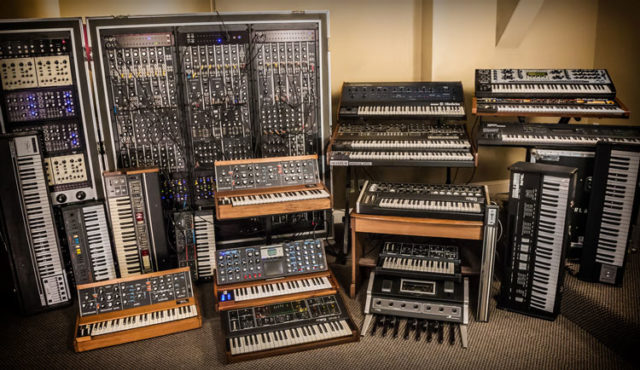Last Updated on August 11, 2017 by Andrew Culture
Since the advent of the fully-fledged DAW, software manufacturers have strived to produce the ultimate plugins, with realistic versions of analogue hardware possibly being the hardest to recreate with any authenticity. In recent years however, said manufacturers have come closer to achieving the ultimate goal of fooling everyone with the latest soft Neve channel or esoteric synth being brought to the seemingly stuffed market and so, we ask ourselves, why would we want more of the same.
If you give it a cursory glance Syntronik, IK Multimedia’s latest offering, is a collection of 17 classic vintage synths, most of which have been cloned, sampled, synthesized and been available before from various manufacturers. However, give it a closer look and you’ll see something (actually, quite a lot) that might set this collection apart from the crowd.
Syntronik – The basics
To begin with, Syntronik is not small. In fact, it’s as big as some of the professional symphonic instrument libraries at around 50GB, due to the fact that the software is based on samples, and lots of them. Sampling every possible oscillator, filter and control set for such a large number of synths would break anyone and so this collection is built on a hybrid of samples and modelling synthesis. The second thing to be aware of is that, although the collection is 17 instruments, some of these are sampled from a number of different models from the same family of synths. For example, the Minimod gathers elements from the Modular Moog, Minimoog Model D and the Moog Voyager. In all, the collection is based on a whopping 37 different synths and includes over 2000 presets.
With that in mind, you need to be prepared for a bit of a wait to download the complete collection. It took around two-and-a-half hours on my fairly modest broadband, so you’ll have to be patient, but if you can’t then there is a boxed USB drive version available at an extra cost. Using IK’s authorization manager is simple (type in your serial number and download the files) and installation of the main application took no time at all. As this is such a large collection (and because of the way that IK lets you buy the synths individually, more of which later) you have to install 23 separate files if you want to use the full package from the off, which again took about an hour.
Easy as 1, 2, 3…
The upside to the rather drawn out process of downloading and installing the software is how easy it is to use. This ease is thankfully not at the expense of the sounds that can be generated, or to the depth that you can go into making them and IK should be applauded for making the program very intuitive. There are 5 main pages that make up the majority of what the software does; the browser, the effects, the layer controls, arpeggiator and the synth ‘face’ itself.
The browser is the first thing you see when you fire up the software and it offers filters and a search function to home in on the style of preset to begin your musical combobulations. You can search by the synth type, filter using keywords or a combination of both. In the centre of the page the presets to match your choices appear and on the right-hand side is a description of the preset as well as the size (remember, it’s sample based) for all those with precious RAM resources. To be fair, IK have their own proprietary data compression in their other products, such as SampleTank, and I suspect the same is in use here and so the RAM usage is quite modest.

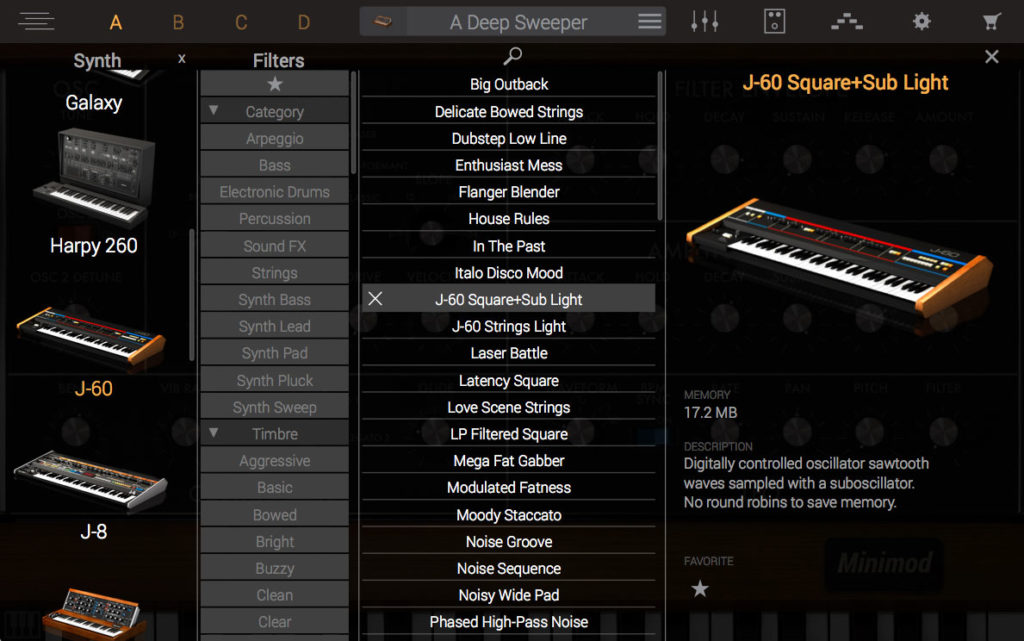
It’s a syn-th
Once you have chosen a preset, you can toggle between the other pages, although you will be mainly using the synth page itself to get to grips with the bulk of the sound shaping controls. And this is where IK has, in my opinion, been very brave with their choice of what these controls actually are. In a collection of such a size, recreating each individual synth exactly could cause countless different headaches, not least of which for the musician learning how each synth with their esoteric control set works. So, within Syntronik, the parameters that are available are identical for whichever synth you are working with.
The UI might look like a photo-realistic Moog, where in the real world the controls are totally different to a Juno-60, but look closely and you will see a uniform set of parameters across the whole collection. So, for each synth you will get 2 oscillators, a filter section, envelopes for the filter and amplitude, a LFO, controllers for pitch bend, vibrato and modes for mono- or polyphonic play and 2 types of legato.
It is this ‘single’ interface style that I think is a major plus point for this software. The familiarity that it breeds encourages more experimentation across the range of synths as, although the controls for parameters may look slightly different or be in a slightly different place on each UI, they are still recognizable and that makes navigation of the various synths that much easier. Also, unlike other IK software, the UI is resizable so you won’t have to squint at a tiny synth to find the parameter you want.

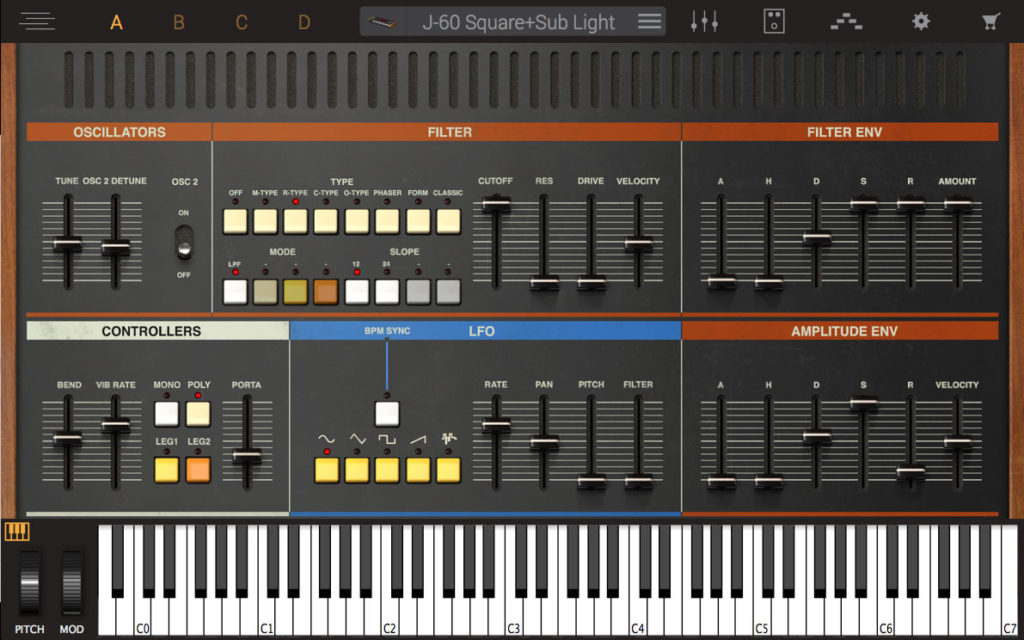
Oscillate wildly
The oscillator section is where the sound creation begins and where IK have put their sampling techniques to good use, as these are the initial sounds taken from the 37 synths the collection is based on.
To achieve a more realistic synth experience, the samples for the oscillators are multi-sampled round robins and incorporate IK’s DRIFT technology that “…varies the phase, colour and pitch of the sampled oscillators to keep them moving…” so it does feel like an analogue synth’s oscillator with all its potential variations is being heard.
One thing stuck out in the oscillator section, which is when you want to retune Osc 1 while holding a note on: it doesn’t! And it took me a few minutes to realize that this is because of the sample-based elements of the software and the fact that you need to re-trigger the note (sample) to hear the effect of the retune. Once realized though, it quickly becomes second nature.
The filter section is again an interesting move for IK and one that, as before, moves the virtual recreations into new territory. They have modelled four specific filters from the best loved synths and made them available to all of the instruments in the collection (remember, they all share the same control sets) as well as including some digital filters as well. So, for example, you can use the Oberheim SEM filter on a Juno oscillator or a Moog transistor ladder filter on a Yamaha SY99. This really does open up some new sonic pathways not available on physical classic synths.
The LFO section is a fairly standard affair which gives you the option of the usual shapes of sine, triangle, square, saw and random and you can have the LFO sync to a tempo in your DAW or free run. You can then modulate pan, pitch and the cut off frequency of the chosen filter. The filter and amplitude envelopes also have a familiar control set of attack, hold decay, sustain and release controls.
Any changes you make to a preset can be saved into a user area, where you can also add extra detail and description just like the included presets, so it will be included in any searches at a later date, which is a nice touch.


Get myself affected…
If all that sound mangling control wasn’t enough, the effects section calls up a virtual rack of 5 slots, ready for 500-style ‘lunchbox’ modules to be plugged in. Some of these are new effects and some are based on others previously available in IK’s T-Racks and AmpliTube software. A drop down menu gives you choices of amps, distortion, dynamics/EQ, modulation, reverb/delay and filters totalling 38 effects. These include emulations of amps from Roland and Ampeg, EQ/dynamics processors from Pultec and Fairchild as well as a host of others. After you have tweaked an effect you can save each one as a preset, but you can’t save a whole rack together and, unfortunately, you can’t reorder the effects after you have plugged them in but these are minor points in an otherwise nicely implemented section.


Never gonna give you arp…
Next in line is the arpeggiator section, which is a far deeper affair than simple up, down and random choices. Each pattern can have any number of steps up to 32 and each step lets you have control of velocity and pitch offset, whether it plays a single note or the whole chord being held and the duration of each step, which also allows them to be tied together.
The combination of some of these factors create some really interesting rhythmic and melodic twists to an otherwise static chord and could be the basis of some compositions without having to add much more. Again, there are many presets to choose from in various pattern lengths and rates to get you started and you can save your own patterns for later use.

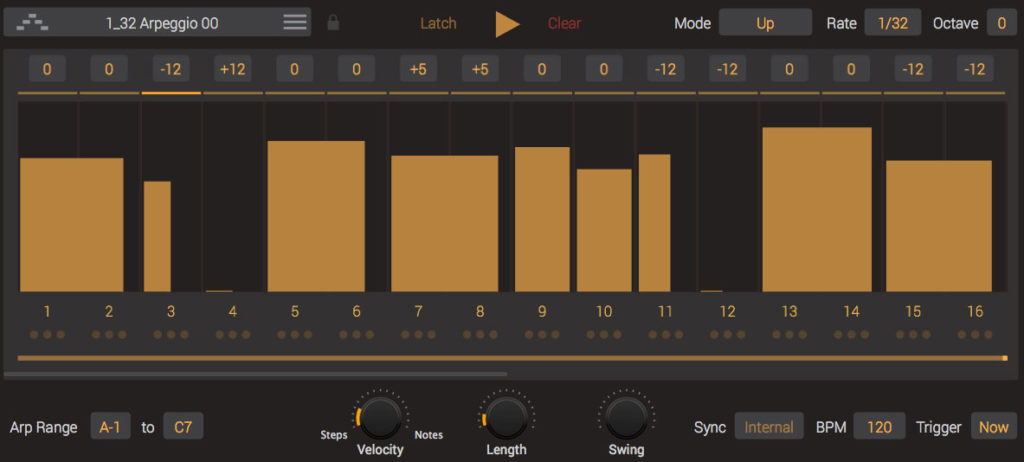
Syntronik Layers
The final main section is the layer panel. Up until now I have described the use of one synth, with one effects rack and one arpeggiator. The layer page lets you combine up to four different synths, effects and arps into one playable machine. Each ‘part’ can either be played separately using key splits or layered together to create an almighty beast of a synth.
Each part has a basic mixer where you can control the pan, solo, mute and level of a part and you will need to use this if you get to four parts layered together, as the volume can get pretty hot.
What Syntronik doesn’t give you, apart from using key split zones, is true multi-timbrality as it is designed to be used as one instrument and can only be addressed by one MIDI channel. Obviously, depending on your computer resources you can have any number of instances of Syntronik available within your DAW, but if you want to use it as standalone you can only have one. Should you wish to have true multi-timbral control, IK have thoughtfully implemented access to the Syntronik instrument collection via their SampleTank software where 16 instruments can be accessed on independent channels, although you lose the Syntronik UI and access to the arpeggiators.

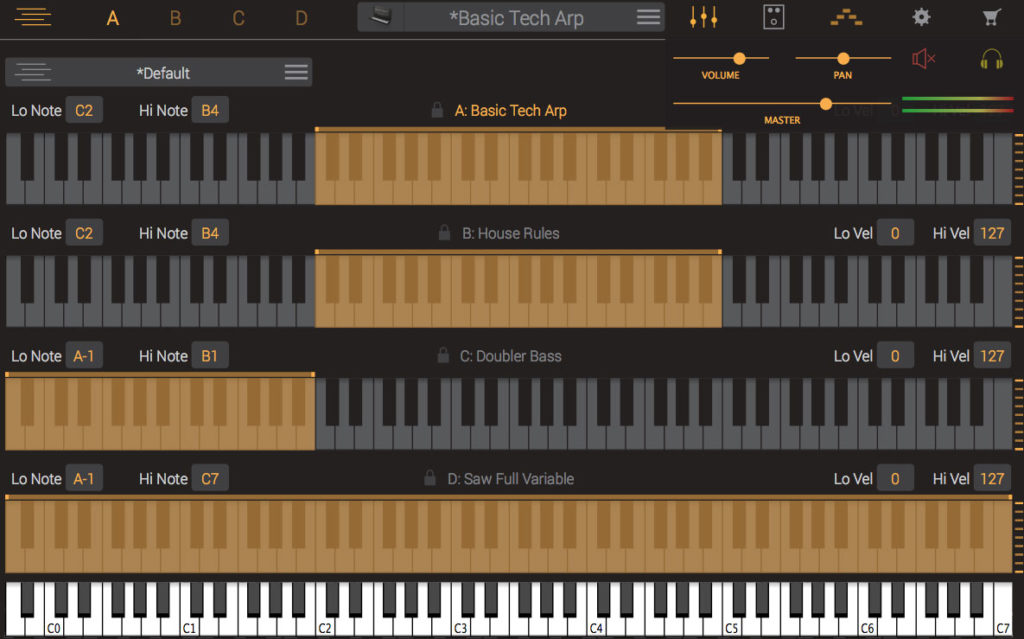
But what’s Syntronik actually like to use?
So, what does it actually sound like? Well, it sounds pretty good to me. I’m not going to sit here and espouse how close it is/isn’t to the hardware units because, frankly, there’s no point.
As these are clearly not like-for-like conversions and because of the adapted control set, it is difficult to recreate a patch from any of the original synths to compare it too, or indeed a soft-version of one. But, what the software gives you is a massive collection of presets that can also be used as starting points for your own sounds.
Each synth has its own unique flavor, from the somewhat cold FM ‘futurism’ of the 99 to the acidized phatness of the T-03, all tastes are catered for. The filtering of styles and synths works well, which is lucky as trawling through 2000 presets is asking quite a lot, as does the search function.
The minimal set of controls, as previously stated, is a big selling point as simplicity is key to quick results in this type of software and I had been playing with the software for a few hours before I wanted to look at the user manual to confirm a few things.
The layer section is a place for extreme experimentation and with different synths, effects and arps all running you can generate some genuinely new and interesting/weird/crazy combinations.
If you’re still not sure whether this is the software for you, IK Multimedia offer a demo version of Syntronik that includes 50 presets as well as the effects, arpeggiator and layer functions so you can try before you buy. If after this you don’t want to commit to the whole package, you can buy and download each synth individually in similar fashion to the AmpliTube and T-Racks custom shop already offered by IK, which is a convenient way of buying software in modular fashion, when and if you need to.
Syntronik – Conclusion
In conclusion, Syntronik is fun and engaging and makes you want to play it, because anything can happen. And that sounds similar to what an analog synth can do for you except, this time, you’ve got 17 to choose from.
Find out more about Syntronik…
Pros
- It’s a massive piece of software.
- Some genuinely surprising sounds can be created.
- The arpeggiator is a powerful creative tool.
- UI can be resized.
- Free version + individual synths available.
Cons
- Multiple downloads and installation process is not very user friendly.
- Confusing if you want to re-tune Osc 1 while holding a note down.
- Can’t reorder effects.
- No multi-timbral function (but there is a way round this).
- Not for the purist.
Syntronik System Requirements
Syntronik is a 64-bit application. Requires a 64-bit CPU and Operating System.
Mac® (64-bit)
Minimal: Intel® Core™ 2 Duo, 4 GB of RAM (8 GB suggested), Mac OS X 10.9 or later. 60 GB of hard drive space.
Supported Plug-in formats (64-bit): Audio Units, VST 2, VST 3, AAX.
Windows® (64-bit)
Minimal: Intel® Core™ 2 Duo or AMD Athlon™ 64 X2, 4 GB of RAM (8 GB suggested), Windows® 7, Windows® 8 or Windows® 10. 60 GB of hard drive space. Requires an ASIO compatible sound card.
Supported Plug-in formats (64-bit): VST 2, VST 3, AAX.
Syntronik demo video



